|
 |
| Adult, Kern County |
 |
 |
 |
 |
| Adult, Inyo County |
Adult, San Diego County |
Adult, Inyo County |
Adult, Inyo County |
 |
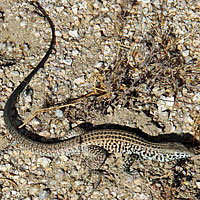 |
 |
 |
| Adult, San Diego County |
Adult, Kern County |
Adult, San Diego County |
Adult, Kern County |
 |
 |
 |
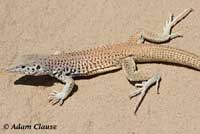 |
Adult, San Bernardino County
© Jeff Ahrens |
Adult with a faded pattern, Imperial County © Keith Condon |
Adult with pink and tan coloration, Imperial County © Adam Clause |
 |
 |
 |
 |
Adult male, Mono County
© Adam Clause |
Adult male, Mono County
© Adam Clause |
Adult, Kern County © Lou Silva |
This Great Basin Whiptail from Riverside County has an abnormal forked tail, probably resulting from an injury.
© Dan Schroeter |
 |
| Adult, San Bernardino County © Mike Ryan |
 |
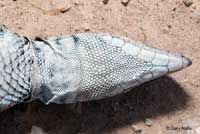 |
 |
 |
| These pictures of a freshly road-killed Imperial County adult serve as a good illustration of this lizard's large belly scales, very long taill, and pale throat. |
In these pictures you can see this lizards transparent lower eyelid -
It is open on the left
It is closed on the right. |
 |
 |
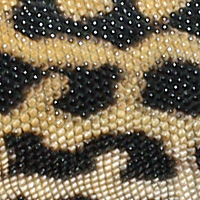 |
|
| CMenck found this adult trapped in some synthetic netting that was accidentally left on the ground in her L.A. County desert yard. After cutting it out of the net, it went on its way and the net was removed. |
Whiptail Tracks in sand |
Whiptails, genus Aspidoscelis, have small granular dorsal scales. |
|
| |
|
|
|
| Juveniles |
 |
 |
 |
Juvenile, Riverside County © Michael Sutton.
This juvenile whiptail was discovered walking on the surface of the water in a swimming pool for about a minute before it started to sink. It was underwater for about 20 seconds before it was rescued. After about two minutes, it came back to life and ran away. |
 |
|
|
|
| Tiny juvenile, aprox. 2 inches long snout-to-vent, Imperial County © Karyn Sieglitz |
|
|
|
| |
| Great Basin Whiptails From Outside California |
 |
 |
 |
 |
| |
Adult, Washoe County, Nevada |
|
 |
|
|
|
| Juvenile, Washoe Co., Nevada |
|
|
|
| |
|
|
|
| Predation |
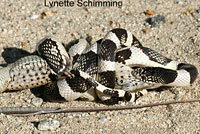 |
 |
 |
|
| A Long-nosed Snake eating a Great Basin Whiptail © Lynette Schimming. |
|
 |
 |
 |
|
Adult Long-nosed Leopard Lizard eating a Great Basin Whiptail on a road in San Bernardino County. (It is not known if the whiptail was killed by the leopard lizard or if it was dead before it was consumed.
© Alexandra Hicks
|
A Greater Roadrunner with a freshly killed Great Basin Whiptail in San Bernardino County. © Dave Feliz
You can also watch a short YouTube video of this bird perched on top of a bush with the lizard in its beak as it sings. After singing it flew down to its nest in a cholla cactus where it probably fed the whiptail to its young. |
This juvenile Long-nosed Leopard Lizard is eating a juvenile Great Basin Whiptail in Inyo County. Swallowing the complete tail is probably going to take some time.
© Jaye B |
|
| |
|
|
|
| Habitat |
 |
 |
 |
 |
| Habitat, Inyo County |
Habitat, San Diego County
|
Habitat, Inyo County |
Habitat during Spring wildflower bloom, San Diego County |
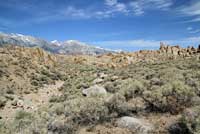 |
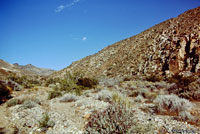 |
 |
 |
| Habitat, Inyo County |
Habitat, San Bernardino County |
Habitat, Riverside County
|
Habitat, Imperial County desert
|
 |
 |
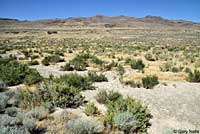 |
 |
Habitat, Kern County
|
Habitat, Inyo County |
Habitat, Great Basin desert,
4,000 ft.,
Lassen County |
Habitat, rocky wash, Inyo County |
 |
 |
 |
 |
Habitat in Spring, Kern County
© Lou Silva |
Habitat, Kern County |
Habitat, Inyo County |
Habitat, Inyo County |
 |
 |
|
|
| Habitat, San Diego County |
Habitat, San Diego County |
|
|
| |
|
|
|
| Short Videos |
 |
 |
 |
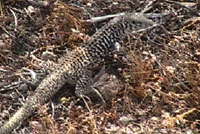 |
| A Great Basin Whiptail in the Kern County Mohave Desert digs around looking for food, then eats a red ant, but has trouble with it. |
A Great Basin Whiptail climbs up into a desert shrub to search for food. |
A noosed whiptail is released, but decides not to move until prodded and then it disappears in a flash. |
Views of a couple of Great Basin Whiptails in the desert. |
 |
|
|
|
Two Great Basin Whiptails forage along the ground and on a rock outcrop with their characteristic slow and jerky movement.
|
|
|
|
| |
|
|
|
| Description |
| |
| Size |
Aspidoscelis tigris as a species is 2 3/8 - 5 inches inches long snout to vent (6 - 12.7 cm), up to around 13 inches (33 cm) total length.
|
| Appearance |
A slim-bodied lizard with a long slender tail, a pointed snout, and large symmetrical head plates.
Scales on the back are small and granular, and scales on the tail are keeled
The belly is made of large, smooth, rectangular scales in 8 lengthwise rows.
The tail can reach up to two times the length of the body.
|
| Color and Pattern |
The back and sides are grey, tan, or brown, marked with dark spots or bars or mottling, which is often very sharply defined. Dark marks on the sides often form vertical bars. Usually 4 faint light stripes are present along the back.
These stripes fade with age.
Often there are reddish patches on the sides of the belly.
The throat is pale with with obscure black spots.
The tail tip is dark or bluish.
|
| Young |
Juveniles have fairly well-defined stripes.
In the San Diego area, juveniles are spotted.
The tail tip is bright blue on juveniles.
|
| Life History and Behavior |
Activity |
Diurnal.
Wary and very active, moving with abrupt stops and starts, side-to-side head movement, and tongue flicking.
Often seen digging rapidly when foraging.
Difficult to approach - typically foraging near cover, and capable of quick bursts of speed into heavy brush or holes. |
| Diet and Feeding |
Eats small invertebrates, especially spiders, scorpions, centipedes, and termites, and small lizards.
A Great Basin Whiptail was observed catching and consuming a Sagebrush Lizard in Inyo County.
(Herpetological Review 38(4), 2007) |
| Reproduction |
Unlike some species of whiptails which are all females, there are male and female western whiptails.
Males and females mate, usually beginning in May in the southern part of their range or in June in the northern part of the range, with females laying eggs in May or June.
Females lay one clutch of eggs per year.
Eggs hatch from June to August.
|
| Habitat |
Found in a variety of ecosystems, primarily hot and dry open areas with sparse foliage - deserts, chaparral, sagebrush, woodland, and riparian areas. Avoids areas with dense growth.
|
| Geographical Range |
In California, this subspecies ranges from the Great Basin deserts in the north - the Honey Lake Basin and the Surprise Valley - east of the Sierras into the Mojave and Colorado Deserts.
The species (Aspidoscelis tigris) ranges from Oregon and southern Idaho, south through California and Nevada to Baja California, and east into Utah, Colorado, Arizona, and New Mexico and south into Sonora and Sinaloa, Mexico.
Occurrence in Northeast California
At one time I showed this species present in much of Shasta, Siskiyou, Modoc, and Lassen Counties. The California Dept. of Fish and Wildlife map shows the species present in these counties, but the 2012 and 2018 Stebbins & McGinnis field guides show a question mark in the area. I have looked for them in the area and searched museum records for them but I have found no records for them in Siskiyou or Modoc counties. There are no iNaturalist observations for the species from these counties, either, though that could be due to it being sparsely-populated. For these reasons my maps no longer show it occurring in Siskiyou and Modoc counties, except for in the desert east of the Warner Mountains where it's possible they occur since they're in similar habitat to the east in Nevada.
|

|
| Elevational Range |
The species is found at sea level to 7,000 ft. (2,130 m). This subspecies may differ somewhat.
|
| Notes on Taxonomy |
Reeder et al. (2002) re-examined the nomenclature for the genus Cnemidophorus and split it into the two genera Aspidoscelis and Cnemidophorus. Cnemidophorus tigris became Aspidoscelis tigris.
------------------------------------------------------------------------------------------------------------------------------------------------------------------------------------------------------------------------------
"See de Queiroz et al. (2017, SSAR Herpetological Circular 43: 41) regarding the incomplete separation of this species from A. marmoratus. Mitochondrial clades inferred by Chafin et al. (2021, Frontiers of Biogeography 13.2, e49120) are largely congruent with the previously recognized subspecies A. t. mundus, A. t. punctilinealis, and A. t. septentrionalis, although A. t. punctilinealis would extend west of the Colorado River into southeastern California. A. t. tigris was sparsely sampled but may correspond to clade F, while A. t. stejnegeri was not sampled."
(Nicholson, K. E. (ed.). 2025 SSAR Scientific and Standard English Names List)
------------------------------------------------------------------------------------------------------------------------------------------------------------------------------------------------------------------------------
“Tiger” was added to the standard English name to make it more descriptive.
(Nicholson, K. E. (ed.). 2025 SSAR Scientific and Standard English Names List)
------------------------------------------------------------------------------------------------------------------------------------------------------------------------------------------------------------------------------
Alternate and Previous Names (Synonyms)
Aspidoscelis tigris tigris - Great Basin Tiger Whiptail (Nicholson, K. E. (ed.). 2025 SSAR Scientific and Standard English Names List)
Aspidoscelis tigris - Tiger Whiptail (SSAR scientific and standard English names list 8th edition 2017)
Cnemidophorus tigris tigris - Great Basin Whiptail (Stebbins 1954, 1966, 2003)
Cnemidophorus tessselatus tesselatus - Common Tesselated Racerunner (Smith 1946)
Cnemidophorus tigris tigris - Desert Whip-tailed Lizard (Cnemidophorus gracilis; Cnemidophorus tessellatus tigris, part; Cnemidophorus tessellatus tessellatus, part; Cnemidophorus sexlineatus var. tesselatus; Cnemidophorus sexlineatus var. bocourtii. Desert Whip-tail; Swift Jack; Tessellated Lizard; Tiger Armor-bearer; Tiger Lizard) (Grinnell and Camp 1917)
|
| Conservation Issues (Conservation Status) |
| None |
|
|
Taxonomy |
| Family |
Teiidae |
Whiptails and Racerunners |
Gray, 1827 |
| Genus |
Aspidoscelis (formerly Cnemidophorus) |
Whiptails |
Fitzinger, 1843 |
| Species |
tigris |
Western Whiptail |
(Baird and Girard, 18s52) |
Subspecies
|
tigris |
Great Basin Whiptail |
(Baird and Girard, 1852) |
|
Original Description |
(Cnemidophorus tigris - Baird and Girard, 1852 - Proc. Acad. Nat. Sci. Philadelphia, Vol. 6, p. 69)
from Original Description Citations for the Reptiles and Amphibians of North America © Ellin Beltz
|
|
Meaning of the Scientific Name |
Aspidoscelis - Greek - aspido = shield + skelos = leg
tigris - Latin = of a tiger - refers to the dorsal pattern
Taken in part from Scientific and Common Names of the Reptiles and Amphibians of North America - Explained © Ellin Beltz
|
|
Related or Similar California Lizards |
California Whiptail - A. t. munda
Coastal Whiptail - A. t. stejnegeri
Belding's Orange-throated Whiptail - Aspidoscelis hyperythra beldingi
|
|
More Information and References |
California Department of Fish and Wildlife
Hansen, Robert W. and Shedd, Jackson D. California Amphibians and Reptiles. (Princeton Field Guides.) Princeton University Press, 2025.
Stebbins, Robert C., and McGinnis, Samuel M. Field Guide to Amphibians and Reptiles of California: Revised Edition (California Natural History Guides) University of California Press, 2012.
Stebbins, Robert C. California Amphibians and Reptiles. The University of California Press, 1972.
Flaxington, William C. Amphibians and Reptiles of California: Field Observations, Distribution, and Natural History. Fieldnotes Press, Anaheim, California, 2021.
Nicholson, K. E. (ed.). 2025. Scientific and Standard English Names of Amphibians and Reptiles of North America North of Mexico, with Comments Regarding Confidence in Our Understanding. Ninth Edition. Society for the Study of Amphibians and Reptiles. [SSAR] 87pp.
Samuel M. McGinnis and Robert C. Stebbins. Peterson Field Guide to Western Reptiles & Amphibians. 4th Edition. Houghton Mifflin Harcourt Publishing Company, 2018.
Stebbins, Robert C. A Field Guide to Western Reptiles and Amphibians. 3rd Edition. Houghton Mifflin Company, 2003.
Behler, John L., and F. Wayne King. The Audubon Society Field Guide to North American Reptiles and Amphibians. Alfred A. Knopf, 1992.
Robert Powell, Roger Conant, and Joseph T. Collins. Peterson Field Guide to Reptiles and Amphibians of Eastern and Central North America. Fourth Edition. Houghton Mifflin Harcourt, 2016.
Powell, Robert., Joseph T. Collins, and Errol D. Hooper Jr. A Key to Amphibians and Reptiles of the Continental United States and Canada. The University Press of Kansas, 1998.
Bartlett, R. D. & Patricia P. Bartlett. Guide and Reference to the Turtles and Lizards of Western North America (North of Mexico) and Hawaii. University Press of Florida, 2009.
Jones, Lawrence, Rob Lovich, editors. Lizards of the American Southwest: A Photographic Field Guide. Rio Nuevo Publishers, 2009.
Smith, Hobart M. Handbook of Lizards, Lizards of the United States and of Canada. Cornell University Press, 1946.
Taylor, Emily. California Lizards and How to Find Them. Heyday, Berkeley, California. 2025.Brown et. al. Reptiles of Washington and Oregon. Seattle Audubon Society,1995.
Nussbaum, R. A., E. D. Brodie Jr., and R. M. Storm. Amphibians and Reptiles of the Pacific Northwest. Moscow,
Idaho: University Press of Idaho, 1983.
St. John, Alan D. Reptiles of the Northwest: Alaska to California; Rockies to the Coast. 2nd Edition - Revised & Updated. Lone Pine Publishing, 2021.
Brennan, Thomas C., and Andrew T. Holycross. Amphibians and Reptiles in Arizona. Arizona Game and Fish Department, 2006.
Degenhardt, William G., Charles W. Painter, & Andrew H. Price. Amphibians and Reptiles of New Mexico. University of New Mexico Press, 1996.
Williamson, Michael A., Paul W. Hyder, & John S. Applegarth. Snakes, Lizards, Turtles, Frogs, Toads & Salamanders of New Mexico. Sunstone Press, 1994.
Joseph Grinnell and Charles Lewis Camp. A Distributional List of the Amphibians and Reptiles of California. University of California Publications in Zoology Vol. 17, No. 10, pp. 127-208. July 11, 1917.
|
|
|
The following conservation status listings for this animal are taken from the July 2025 State of California Special Animals List and the July 2025 Federally Listed Endangered and Threatened Animals of California list (unless indicated otherwise below.) Both lists are produced by multiple agencies every year, and sometimes more than once per year, so the conservation status listing information found below might not be from the most recent lists, but they don't change a great deal from year to year.. To make sure you are seeing the most recent listings, go to this California Department of Fish and Wildlife web page where you can search for and download both lists:
https://www.wildlife.ca.gov/Data/CNDDB/Plants-and-Animals.
A detailed explanation of the meaning of the status listing symbols can be found at the beginning of the two lists. For quick reference, I have included them on my Special Status Information page.
If no status is listed here, the animal is not included on either list. This most likely indicates that there are no serious conservation concerns for the animal. To find out more about an animal's status you can also go to the NatureServe and IUCN websites to check their rankings.
Check the current California Department of Fish and Wildlife sport fishing regulations to find out if this animal can be legally pursued and handled or collected with possession of a current fishing license. You can also look at the summary of the sport fishing regulations as they apply only to reptiles and amphibians that has been made for this website.
This animal is not included on the Special Animals List, which indicates that there are no significant conservation concerns for it in California.
|
| Organization |
Status Listing |
Notes |
| NatureServe Global Ranking |
|
|
| NatureServe State Ranking |
|
|
| U.S. Endangered Species Act (ESA) |
None |
|
| California Endangered Species Act (CESA) |
None |
|
| California Department of Fish and Wildlife |
None |
|
| Bureau of Land Management |
None |
|
| USDA Forest Service |
None |
|
| IUCN |
|
|
|
|
 Red: Range of this subspecies in California
Red: Range of this subspecies in California
































































